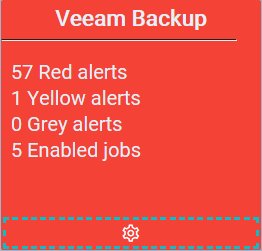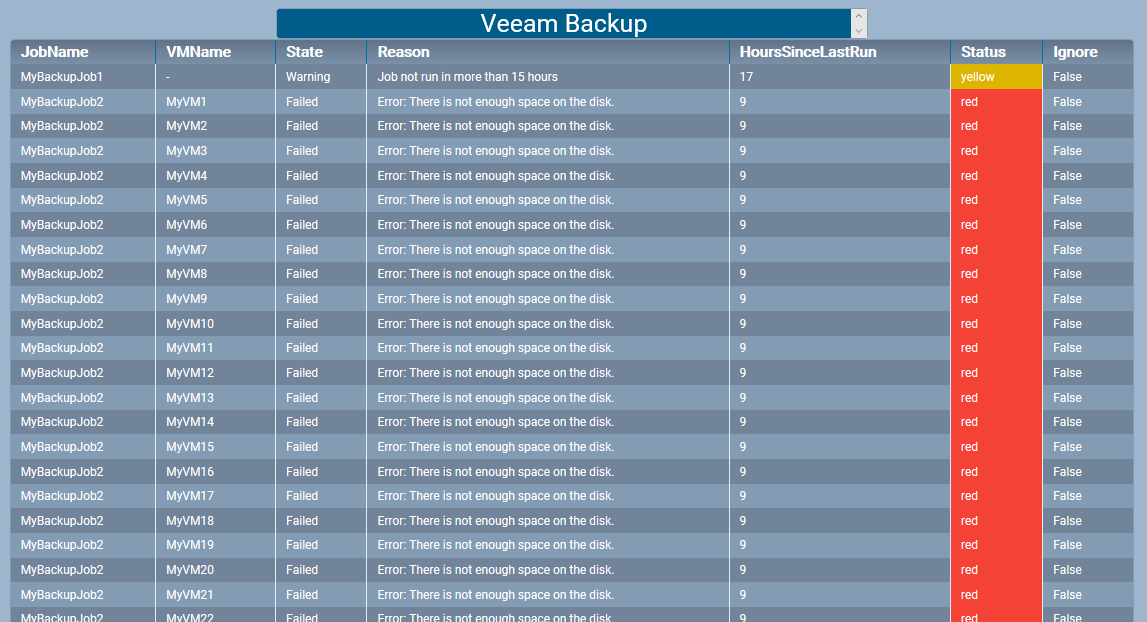CURE - Detector Veeam Backup
CURE - The homebrewed monitoring solution. Read more about it in my previous posts:
- CURE-Design
- CURE-Environment
- CURE-Database design
- CURE-Detector foundation
- CURE-Detector-step-by-step
- CURE-GUI
Background
As covered in a previous post, Veeam is used for backup of the company’s VMware VMs.
I will describe the steps I did for setting up a CURE detector for Veeam based on the DetectorTeamplate.ps1 described in CURE-Detector foundation and the instructions in CURE-Detector-step-by-step. The whole detector script can be found here
Approach
Luckily there are CmdLets (PowerShell native binary modules) available for Veeam. That makes the interaction easy when building a custom detector. I wanted to monitor the success of individual backup jobs, but also wanted to monitor that all jobs have actually ran within a set amount of time. To get access to the Veeam CmdLets I installed the “management and console” tools on the Detector Host.
LOCAL SETTINGS, FUNCTIONS AND DEPENDENCIES
asnp VeeamPSSnapIn
$detectorName = "Veeam Backup"
$veeamsrv = "MyVeeamServer.fqdn"
$HoursSinceJobLastRunYellow = 50
$HoursSinceJobLastRunRed = 80
$knownStatuses = @("Success","Failed","Warning")
$warningExceptions = @{
"MyVM1" = "Changed block tracking cannot be enabled: one or more snapshots present*";
"MyVM2" = "Unable to truncate Microsoft SQL Server transaction logs*";
"MyVM3" = "Another warning to suppress*"
}
$JobNameFilter = "BACKUP*"
This is the detector specific settings I ended up with. I decided to create an $warningExceptions * hash table in order to easily be able to suppress warnings I didn’t want to see. *$JobNameFilter is to filter on jobs with a specific name prefix. In my case I don’t care about some other one-off jobs and/or archive-jobs, so I’ve named the Veeam jobs I want to monitor “BACKUP-xxx”.
CONNECT AND COLLECT
<# this is custom #>
try {Connect-VBRServer -Server $veeamsrv -EA stop -WA silentlycontinue}
catch {
$localEvent.descriptionDetails = $_
$localEvent.status = 'grey'
$localEvent.eventShort = "Unable to connect to $veeamsrv"
$Disconnected = $True
}
If (!$Disconnected)
{
try {$veeamjobs = Get-VBRJob -EA stop -WA silentlycontinue | where {($_.name -like $JobNameFilter) -and ($_.IsScheduleEnabled)}}
catch {
$localEvent.descriptionDetails = $_
$localEvent.status = 'grey'
$localEvent.eventShort = "Unable to collect jobs from $veeamsrv"
$Uncollected = $True
}
}
This is the CONNECT AND COLLECT section of the script. The connection is established with Connect-VBRServer and with Get-VBRJob I collect the backup jobs info. I filter on jobs prefixed with “BACKUP” and also only jobs that has an active schedule.
ANALYZE
<# this is custom #>
If (!$Disconnected -and !$Uncollected)
{
If (!$veeamjobs)
{
$localEvent.descriptionDetails = "There are no enabled jobs on $veeamsrv"
$localEvent.status = 'grey'
$localEvent.eventShort = "There are no enabled jobs on $veeamsrv"
}
else
{
$report = @()
$failedjobs = $veeamjobs | where {([math]::Round(((get-date) - $_.Info.ScheduleOptions.LatestRunLocal).totalhours) -gt $HoursSinceJobLastRunYellow) -or ($_.Info.LatestStatus -notlike "Success")}
if ($failedjobs)
{
foreach ($j in $failedjobs)
{
$Result = Get-VBRBackupSession | Where {$_.jobId -eq $j.Id.Guid} | Sort EndTimeUTC -Descending | Select -First 1
$FailedVms=$Result.GetTaskSessions() | where {$_.status -notlike "success"}
if (!$FailedVms)
{
$session=Get-VBRSession -Job $j -Last
$message = ($session.Log | where {$_.Status -notlike "Succeeded"} | select -expand title) -join ''
$report += "" | select @{n="JobName";e={$j.name}},@{n="VMName";e={$null}},@{n="State";e={$null}},@{n="Reason";e={$message}},@{n="HoursSinceLastRun";e={[math]::Round(((get-date) - $j.Info.ScheduleOptions.LatestRunLocal).totalhours)}},@{n="Status";e={$null}},@{n="Ignore";e={$false}}
}
else
{
$report += $FailedVms | select JobName,@{n="VMName";e={$_.Name}},@{n="State";e={$_.Status}},@{n="Reason";e={$_.info.Reason}},@{n="HoursSinceLastRun";e={[math]::Round(((get-date) - $j.Info.ScheduleOptions.LatestRunLocal).totalhours)}},@{n="Status";e={$null}},@{n="Ignore";e={$false}}
}
}
foreach ($r in $report)
{
if (!$r.State)
{
if ($r.HoursSinceLastRun -gt $HoursSinceJobLastRunRed) {$r.State = "Failed"; $r.Reason = "Job not run in more than $HoursSinceJobLastRunRed hours"}
elseif ($r.HoursSinceLastRun -gt $HoursSinceJobLastRunYellow) {$r.State = "Warning"; $r.Reason = "Job not run in more than $HoursSinceJobLastRunYellow hours"}
else {$r.State = "Unknown"; $r.Reason = "Unable to get reason"}
}
if (!$r.VMName) {$r.VMName = "-"}
if ($r.State -like "Failed") {$r.Status = "red"}
elseif (($r.State -like "Warning") -and ($r.Reason -like $warningExceptions.$($r.VMName))) {$r.Status = "green"; $r.Ignore = $true}
elseif ($r.State -like "Warning") {$r.Status = "yellow"}
else {$r.Status = "grey"}
}
}
else
{
$report = $veeamjobs | select @{n="JobName";e={$_.name}},@{n="VMName";e={"-"}},@{n="State";e={$_.Info.LatestStatus.ToString()}},@{n="Reason";e={$null}},@{n="HoursSinceLastRun";e={[math]::Round(((get-date) - $_.Info.ScheduleOptions.LatestRunLocal).totalhours)}},@{n="Status";e={"green"}},@{n="Ignore";e={$false}}
}
$noRed = (Get-ItemCount ($report | where {$_.Status -like "red"}))
$noYellow = (Get-ItemCount ($report | where {$_.Status -like "yellow"}))
$noGrey = (Get-ItemCount ($report | where {$_.Status -like "grey"}))
$noEnabledJobs = (Get-ItemCount $veeamjobs)
if ($noRed -ge 1) {$localEvent.status = "red"}
elseif ($noYellow -ge 1) {$localEvent.status = "yellow"}
elseif ($noGrey -ge 1) {$localEvent.status = "grey"}
else {$localEvent.status = "green"}
$localEvent.eventShort = "$noRed Red alerts, $noYellow Yellow alerts, $noGrey Grey alerts, $noEnabledJobs Enabled jobs"
$localEvent.descriptionDetails = ($report | ConvertTo-Json)
$localEvent.contentType = "json"
}
}
Veeam objects turned out to be a bit tricky to work with. I had to dig through a lot of documentation and manually going through all properties of the objects to achieve what I wanted:
- If a job had failed, I wanted to extract which VMs had failed (if any).
- If a job had not run within a set number of hours, I wanted them to be yellow/red.
These prerequisites turned out to be a bit of a brain twister, hence the large amount of code. Row 14-45 deals with the scenario that one or more jobs have not succeeded and/or not ben run within the set amount of time. On row 16-30 I extract the more exact reasons for the unsuccessful job (Get-VBRSession), and also, if available, the specific VMs that have failed and why (Get-VBRBackupSession). Warnings that should be suppressed is dealt with on row 41. Row 46-49 deals with the desired outcome, namely all jobs having run successfully within the set time period.
Result
Here’s how the detector would look in the UI with one failed job, and one job that has not run within the set amount of hours.

And if you click the headline you get the details of the events including the VMs that have failed and why.

The personal experiences, viewpoints and opinions expressed in this blog post are my own and in no way represent those of the company.
